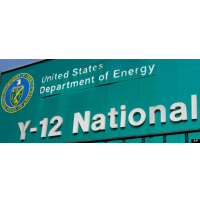Raising Roof of New Nuclear Weapons Complex by 13 Feet Adds $540 Million in Cost and Heightened Risk
 (AP Photo)
(AP Photo)
A long delayed nuclear weapons facility slated for construction in Tennessee will cost an additional $540 million just to raise its roof by 13 feet.
A new report (pdf) released by the Government Accountability Office (GAO) blamed the added cost on the lead design firm hired by the National Nuclear Security Administration (NNSA), which oversees the nation’s nuclear weapons complex, to develop the Uranium Processing Facility (UPF) at the Y-12 national security complex in Oak Ridge. The firm, Babcock & Wilcox Technical Service, a partnership of Babcock & Wilcox and Bechtel, failed to “adequately manage and integrate the design work” of four subcontractors, according to the GAO.
The design problem has resulted in the facility’s roof needing to be elevated another 13 feet in order to fit all of the equipment and other contents planned for the uranium facility.
Construction of the building has not begun, but this problem has caused the project’s “phase one” completion date to be pushed back another five years, from 2020 to 2025. While the facility is slated to be “operational” by that date, it is not expected to be fully equipped until 2038.
The revised timetable has raised concerns about the safety of the plant’s World War II-era 9212 uranium processing complex, which the new UPF is designed to replace. The old complex is said to be deteriorated, with upgrading to current standards deemed impossible. Operations in that structure have been described as inconsistent, with repeated equipment failures. It also no longer meets safety requirements or seismic codes.
The NNSA has not responded to media questions regarding worker safety at the old complex, according to Frank Munger of the Knoxville News Sentinel. The delay now means that the dilapidated facility will have to operate for another 12 years.
In a 2009 interview with the newspaper, Y-12’s then-general manager, Darrel Kohlhorst, said that if a replacement complex was not built and operational between 2018 and 2020, “you may be out of luck. Because there’s going to become a trigger point where the infrastructure, where this facility, is just not safe to continue operating.”
When it was first proposed, the project was expected to cost a total of $1.1 billion to complete. Now, that figure has soared to $6.5 billion, and the cost might increase further because the roof revision burned through nearly half of NNSA “contingency” funds, the GAO found.
-Danny Biederman, Noel Brinkerhoff
To Learn More:
Contractors Slammed for Uranium Project's Ballooning Expense (by Diane Barnes, Global Security Newswire)
Feds Confirm Slowdown on UPF, Raising Questions about Cost, Safety (by Frank Munger, Knoxville News Sentinel)
Briefing on the Uranium Processing Facility: Factors Leading to Cost Increases (Government Accountability Office) (pdf)
The Government Project that is $6 Billion Over Budget and 10 Years Late (by Matt Bewig, AllGov)
Nuclear Complexes Could Save Billions by Shopping at Hardware Store Instead of Building New Facilities (by Noel Brinkerhoff, AllGov)
- Top Stories
- Unusual News
- Where is the Money Going?
- Controversies
- U.S. and the World
- Appointments and Resignations
- Latest News
- Musk and Trump Fire Members of Congress
- Trump Calls for Violent Street Demonstrations Against Himself
- Trump Changes Name of Republican Party
- The 2024 Election By the Numbers
- Bashar al-Assad—The Fall of a Rabid AntiSemite






Comments